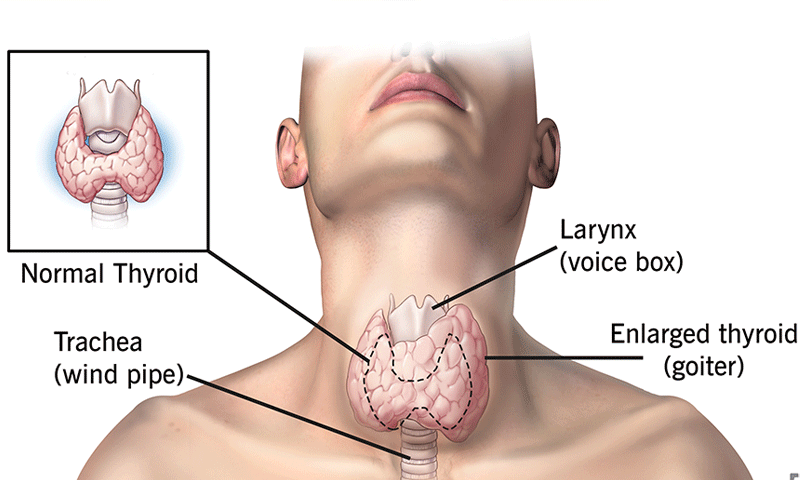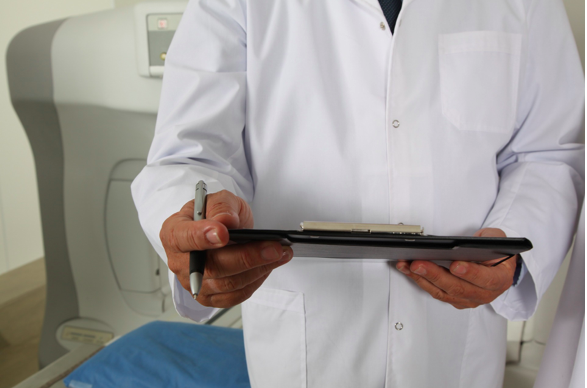The human body one complex organic machine all the organs are interconnected to work in synergy; from the heart to the skin. However, from high school biology, it is well known that the organs are made of even smaller pieces. Of such pieces is the thyroid (https://en.wikipedia.org/wiki/Thyroid) gland that is critical to our bodies physiology. This article seeks to educate about this essential part of the body.
The Thyroid gland
Located just below the voice box, thyroid measures about 2 inches and weighs between 0.5-2 ounces. It is part of the endocrine system. It is butterfly-shaped with two lobes; a left and a right one that are connected by a narrow tissue. It is slightly larger in females than in males. The thyroid gland secretes 3 hormones namely;
*Calcitonin: A 32-amino acid hormone responsible for regulating the level of calcium and phosphate levels in the blood.
*Triiodothyronine (T3): In its active form, it is thyroxine and it is involved in the regulation and controlling a number os systems like the muscles, brain, digestive, heart, the body’s metabolism among others.
Tetraiodothyronine (T4): Responsible for the regulation of the bodies metabolism and the oxidation on a cellular level.
Collectively, the effects of these hormones affect all the parts of the body. The thyroid works by releasing these hormones in the bloodstream and then they are transported to tissues and cells. These hormones affect how our bodies functions and at the same time regulate the amount and the type of nutrients that get into the body.
More specifically the thyroid is involved closely in controlling a good portion, or the whole of the following functions:
*Assisting in brain development
*Contribute to the fetus development during pregnancy and growth of children
*Regulates weight and the digestive system
*Manages the heart and blood pressure
*Regulating metabolism and body temperature
*Aiding in the function of other organs like the eyes, hair, and skin.
It is no wonders that if something goes wrong the thyroid, a lot of systems in our bodies will suffer.
Thyroid Diseases and conditions
According to the American Thyroid Association, approximately 12% of the population will suffer at least one thyroid condition. Roughly 20% have a thyroid disease. However, the worrying fact is that about 60% of this 20 % is unaware that they have a thyroid disease. The following is a list of the commonest thyroid diseases:
Hyperthyroidism
This occurs when there is excess production of hormones into the bloodstream which leads to increased activity in the body’s internal systems. The result of this includes irregular heartbeat, extreme nervousness, anxiety, profuse sweating, dry skin, trembling hands and feet, and sleeping problems.
Treatments depend on the severity of the condition. A pregnant woman may require specialized treatment as the condition may also affect the unborn child. The most common treatments include antithyroid medications or beta-blockers which limit the impact of the thyroid hormones in the body.
Hypothyroidism
This is the opposite of hyperthyroidism. it happens when the thyroid gland produces less hormone than normal. This slows the body’s metabolism. The main cause of this condition is the inflammation or damage of the thyroid or which inhibits the production of hormones. The most common type of Hypothyroidism is Hashimoto’s Thyroiditis, which affects over 14 million Americans.
The common symptoms include skin-related issues (dryness or paleness), the skin may also become stiff or swollen, unexplainable weight gain and fatigue. Treatment is through close monitoring by the doctor. However, those with advanced hypothyroidism may require specialized care, medication or even hormone replacement therapy.
Goiters
This is the inflammation of the thyroid gland. It may be due to the swelling of the whole or due to thyroid nodules. These are multiple nodules that appear on the thyroid. They may be benign and potentially cancerous. The patient may experience hyperthyroidism or hypothyroidism or no symptoms at all.
This condition is mainly attributed to iodine deficiency. It is a rare condition in the US. Treatment depends on the severity of the symptoms and can be done through close monitoring by the doctor.
Graves disease
Discovered by a doctor, Robert Graves, it is similar to hyperthyroidism but in this case, the body produces hormones that make the immune system to create too many antibodies to fight foreign bodies or substances in the body.
It is quite hard to diagnose as the symptoms can be easily confused with other ailments. They include sweating, chest pains, difficulty in breathing, goiters, eye and vision problems, unexplainable weight loss, irregular menstrual cycles among others. Treatment of Graves disease aims at controlling the production of thyroid hormones.
Thyroid Cancer
It is not as common, about 52,000 cases every year, however, the rate of diagnoses is rising. It is more common in women than in men. The most notable symptoms include an abnormal lump in the neck which makes the voice hoarse. There are 4 types of thyroid cancer. Papillary is the commonest of all accounting for over 80% of all cases. The others are Anaplastic, Hurthle or follicular and Medullary.
Thyroid cancer is highly curable and the treatment depends on the severity of the disease. It can be through lobectomy(removal of a single lobe), removal of lymph nodes or in severe cases, removal of the thyroid. Other treatments include radioactive iodine and hormonal therapies.
Maintaining thyroid health
The easiest way to maintain the health of your thyroid glad is by maintaining a good balance of iodine and a constant supply to the thyroid gland. Too much of it may also lead to hypothyroidism. Maintaining a balanced diet and keeping form processed foods with high sugar content will also help. It is also important for you to manage your stress levels and regular exercise and promote hormonal circulation.









